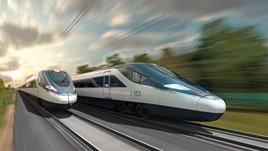HS2 Ltd has confirmed that the classic-compatible train order will now be awarded at the end of this year, rather than in the spring. It means that the trains are likely to be ready for 2028.
There are five bidders for the contract, which is expected to be worth around £2.75 billion for 54 trains plus maintenance. Alstom, CAF, Siemens, Talgo and a Bombardier/Hitachi joint venture have all been asked to tender for the deal.
An HS2 Ltd spokesman told RAIL: “Spring assumed opening Phase 1 in 2026, which is now obviously not possible. The contract award has been shifted back so the trains are ready closer to 2028.”
-
For the FULL story, read RAIL 899, published on February 26, and available digitally now.
















Login to comment
Comments
Allan Turnbull - 26/02/2020 05:53
This order must be placed in the UK anything else would be TREASON as we saw with the Metro order
Allan Turnbull - 26/02/2020 06:07
This order must be placed in the UK anything else would be TREASON as we saw with the Metro order
Angus Munro - 29/02/2020 03:15
Let's hope some of the MPs are beginning to understand that having these trains tilt makes a lot of sense if they are then used to travel 240 miles further from Crewe to Glasgow and Edinburgh. Alstom and Talgo would then be the key bidders if they were asked to supply them with tilt, and will build in the UK! Then there are opportunities to reduce costs on the HS2 Phase2b, NPR build and upgrades as far as Aberdeen which is another 140miles north of Glasgow and 120miles north of Edinburgh. There is DfT/HS2 Freedom of Information data out there that shows a 400kmph HS2 alignment has a radius of curve of 9030m, with a tilting train it is 5400m. See FOI15-1461 11jan16 and FOI15-1257R/1276R 11Nov15 That's a lot fewer tunnels, viaducts and other mitigation measures that need to be build on any future stage of HS2, NPR or upgrade of the existing network, and a lot fewer homes and businesses that would need to be compulsory purchased. Have we not learned any political and sensitivity lessons from Phase 1? And worse, Shapps was suggesting making Phase2b and NPR more circuitous to save money, these trains would still offer 30% faster speeds on corners if he does that. We've just spent years fighting to make HS2 operate at 360kmph as it saves 4-5 minutes to Manchester than travelling at 320kmph plus require 8 extra trains, it would be daft to cut the speed if there was a tilt option that could allow the higher speeds. [HS2 doc no: C240-PBR-OP-REP-000-000026]. The Radius of Curve non-tilt v tilt (with cant=150mm, cant def=200mm) are: 200kmph 2100m v 1348m 250kmph 3300m v 2107m 300kmph 4640m v 2957m 360kmph 7310m v 4369m 400kmph 9030m v 5394m The 9030m non-tilt RoC could come down to 8210m with 80mm cant def. The whole point of these trains is that they will be used off the HS2 line, so should allow for future opportunities to run faster on the existing lines over the next 20-50 years. Both tilt and non-tilt will benefit from ERTMS, or shorter new track sections as built in Denmark where they've built a 60km 300kmph line costing about £1.4m, and approved a further 35km 250kmph line costing €600m. But uniquely these trains can allow running at 250kmph on tilt equipped upgraded existing lines on the same radius of curve 125mph non-tilt line, while new lines in mountainous areas could remain within the lower cost valley floor saving cash but still running faster than today. So yes, the 13 minutes advantage or tilt v non-tilt on the northern section of the WCML will come down to about 7 mins with 125mph non-tilt running later this year, but it is the future possibilities we are buying these trains for. There is no chance of running non-tilt at sustained speeds above 125mph on the many curved sections of the northern WCML, but 155mph is possible with tilt. Ordering these trains would keep all options open, it doesn't burn any bridges, and offers complete flexibility to work around any future rail enhancement. This is particularly true when 160 miles of HS2 is costing £36-£43bn, Government's will delay and prevaricate on future stages over the economic cycles ahead so this gets faster journeys regardless.